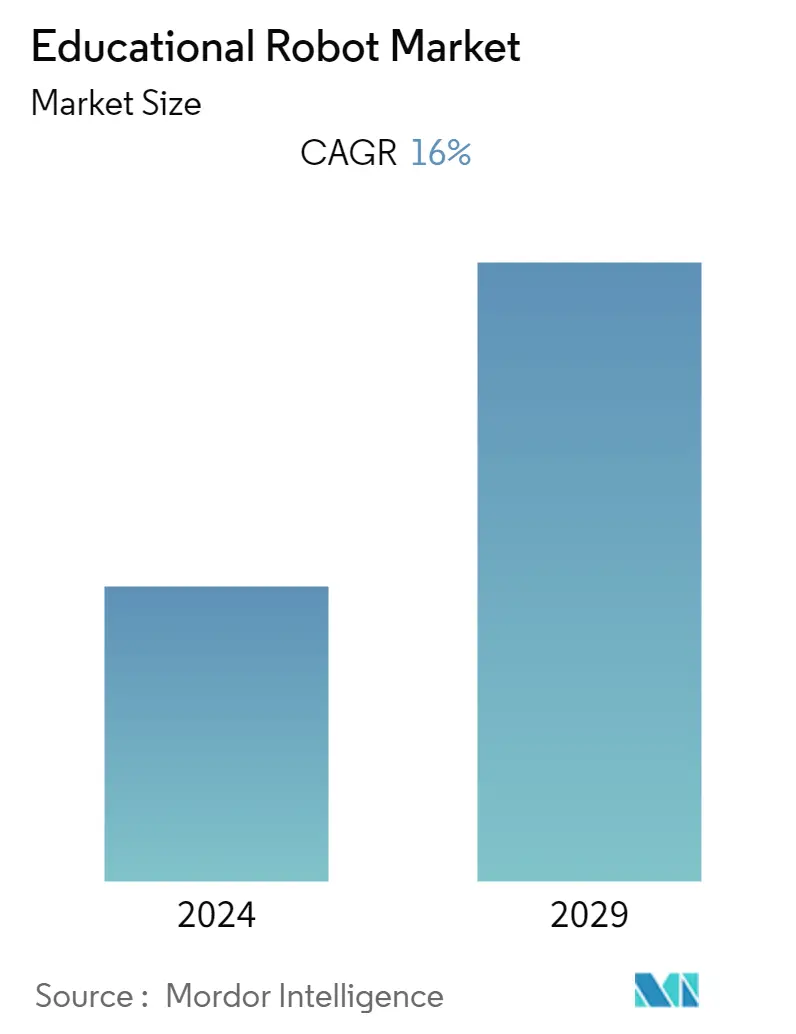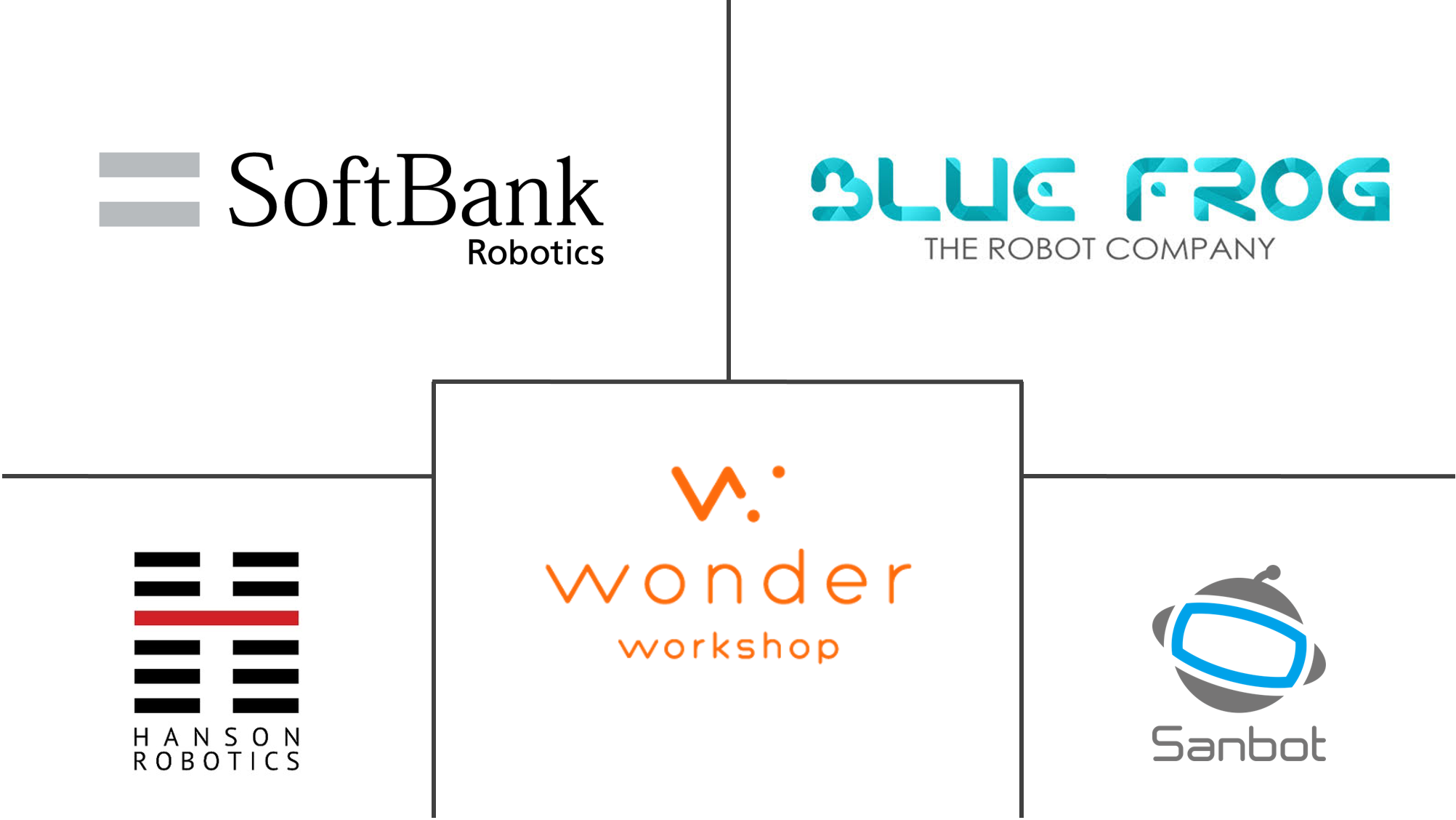Market Size of Educational Robot Industry

| Study Period | 2019 - 2029 |
| Base Year For Estimation | 2023 |
| Forecast Data Period | 2024 - 2029 |
| CAGR | 16.00 % |
| Fastest Growing Market | Asia-Pacific |
| Largest Market | North America |
| Market Concentration | Medium |
Major Players
*Disclaimer: Major Players sorted in no particular order |
Educational Robots Market Analysis
The Educational Robot Market is expected to register a CAGR of 16% over the forecast period. The use of robotics is rapidly becoming more common in educational institutions. Many schools have started testing teaching robots to impart knowledge to their students. These robots can help in delivering lessons in STEM (Science, Technology, Engineering, and Mathematics) concepts that are essential in the educational curriculum.
- Robots can also help children that are homeschooled or teach in areas where human experts are short in supply. For instance, in South Korea, a robot, Robosem, is teaching English where certified English teachers are rare. Similarly, a robot named Keeko narrates stories, possesses logical questions, and interacts with a student using facial expressions in China.
- The use of robotics in learning is ideal for interaction in classrooms as it improves social interaction and encourages collaboration among young children. Playing (and learning) with robots also offer additional benefits for students with disabilities.
- Students with Autism can be very responsive to robots. Robots provide a solution for students with Autism to practice social skills without the pressure of interacting with a real person. Milo (Robokind) is one of the examples of technology being used in schools and clinics for children with an autism spectrum disorder. The robot helps people with Autism in learning social, emotional, and communication skills.
- Moreover, the growing number of individuals with Disabilities Education Act in the United States is also expected to drive the need for educational Robots. According to the Office of Special Education Programs, the number of children aged between 3 to 21 years suffering from Autism accounted for 828 thousand during 2020/2021, compared to 94 thousand in 2000/2001.
- Moreover, robots are increasingly being adopted as teaching assistants or advanced learning tools. One of the teachers at Wellington College (United Kingdom) has predicted that artificially intelligent robots will likely replace educational teachers in the next few years.
- However, high initial investments and maintenance are expected to be one of the major restraints as the robots require a timely update on educational content and require good battery life for conducting classes for hours without recharging.
- While the COVID-19 pandemic increased demand to entertain and educate children, and vendors have been focusing on product launches, Roybi Inc. relaunched its robot Roybi along with the DOCBI model amid current challenges. However, post the pandemic, the requirement for homeschooling and online training increased, which is expected to offset the market growth slightly.
Educational Robots Industry Segmentation
Educational robots have the latest computing power and innovative engineering and can also be controlled via apps and by using voice and gestures. These robots can enhance creative problem-solving techniques and encourage the development of essential communication and interpersonal skills, as well as the ability to collaborate and convey complex ideas to fellow students.
The study analyzes the type of educational robot across geographies, which include North America, Europe, Asia-Pacific, and the Rest of the World. It tracks the key demand-side market dynamics based on base indicators, such as demand for different types of educational robots.
The educational robot market is Segmented by Type (Humanoid, Non-Humanoid) and Geography (North America, Europe, Asia-Pacific, and the Rest of the World).
The market sizes and forecasts are provided in terms of value (USD million) for all the above segments.
| Type | |
| Humanoid | |
| Non-humanoid |
| Geography | |
| North America | |
| Europe | |
| Asia-Pacific | |
| Rest of the World |
Educational Robot Market Size Summary
The educational robots market is experiencing significant growth as robotics becomes increasingly integrated into educational settings. Schools are adopting teaching robots to enhance STEM education, providing interactive learning experiences that improve social interaction and collaboration among students. These robots are particularly beneficial for homeschooling and areas with a shortage of qualified teachers, as seen in countries like South Korea and China. Additionally, robots are proving to be valuable tools for students with disabilities, such as those with autism, by helping them develop social and communication skills in a pressure-free environment. The demand for educational robots is further driven by the growing number of individuals benefiting from the Disabilities Education Act in the United States, highlighting the need for innovative educational solutions.
The market is characterized by a competitive landscape with both small and large players offering a range of products globally. Key companies like SoftBank Robotics, Hanson Robotics Limited, and Wonder Workshop are focusing on product innovation to enhance functionality and expand their market presence. The Asia-Pacific region is poised for significant adoption of educational robots, supported by government initiatives aimed at improving literacy and STEM education. These initiatives, such as India's Atal Tinkering Laboratories, are fostering creativity and technological skills among students. Despite challenges like high initial costs and maintenance, the market is expected to grow as robots are increasingly seen as effective teaching assistants and advanced learning tools, with potential to replace traditional teaching roles in the future.
Educational Robot Market Size - Table of Contents
-
1. MARKET DYNAMICS
-
1.1 Market Overview
-
1.2 Industry Attractiveness - Porter's Five Forces Analysis
-
1.2.1 Threat of New Entrants
-
1.2.2 Bargaining Power of Buyers
-
1.2.3 Bargaining Power of Suppliers
-
1.2.4 Threat of Substitute Products
-
1.2.5 Intensity of Competitive Rivalry
-
-
1.3 Assessment of the Impact of COVID-19 on the Market
-
1.4 Market Drivers
-
1.4.1 Technological Advancement in the Field of Robotics
-
1.4.2 Increasing Demand for Humanoid Robots
-
-
1.5 Market Restraints
-
1.5.1 High Initial R&D Expenditure
-
-
-
2. MARKET SEGMENTATION
-
2.1 Type
-
2.1.1 Humanoid
-
2.1.2 Non-humanoid
-
-
2.2 Geography
-
2.2.1 North America
-
2.2.2 Europe
-
2.2.3 Asia-Pacific
-
2.2.4 Rest of the World
-
-
Educational Robot Market Size FAQs
What is the current Educational Robot Market size?
The Educational Robot Market is projected to register a CAGR of 16% during the forecast period (2025-2030)
Who are the key players in Educational Robot Market?
SoftBank Robotics, Hanson Robotics Limited, Wonder Workshop, Blue Frog Robotics and Sanbot Innovation Technology, Ltd are the major companies operating in the Educational Robot Market.

